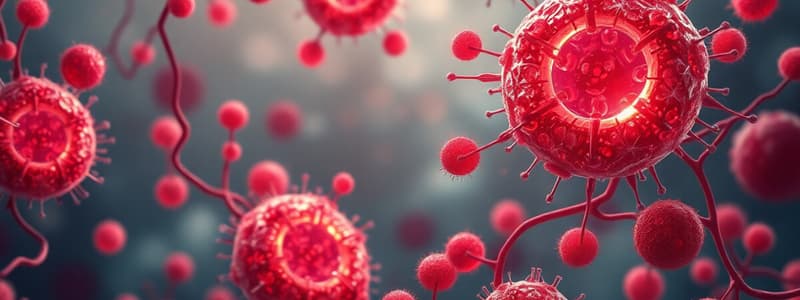Podcast
Questions and Answers
What are the characteristics of a rubricyte's nucleus compared to that of a lymphocyte?
What are the characteristics of a rubricyte's nucleus compared to that of a lymphocyte?
Which statement correctly describes the metarubricyte stage?
Which statement correctly describes the metarubricyte stage?
What is the main difference in the cytoplasm color between rubricytes and lymphocytes?
What is the main difference in the cytoplasm color between rubricytes and lymphocytes?
What unique feature distinguishes the last stage capable of mitosis during red blood cell development?
What unique feature distinguishes the last stage capable of mitosis during red blood cell development?
Signup and view all the answers
What transition occurs immediately after the metarubricyte stage?
What transition occurs immediately after the metarubricyte stage?
Signup and view all the answers
Study Notes
Nucleus and Cytoplasm in Blood Cells
- Nucleus: Round, thin membrane, smaller, and slightly eccentric in rubricytes. Nucleoli present in early stages (0-1 in last stage of nucleolus).
- Cytoplasm: Deeper blue in rubricytes, more abundant compared to normoblasts, due to smaller nucleus. Basophilic. Initial stages of hemoglobin synthesis are also noted here, indicated by chemoglobinization.
- Color of cytoplasm in Rubricyte: Gray - not pink
- Color of cytoplasm in Lymphocyte: Sky blue/Robin's egg blue, muddy or gray-polychromatic
- Color of cytoplasm in Metarubricyte: Salmon-pink
Rubricyte (Polychromic Normoblast)
- Size: 11 to 15 μm
- Nucleus: Round, smaller, thick nuclear membrane, eccentric nucleus.
- Nucleolus: Absent.
- N:C ratio: 1:1
- Function: Precursor to mature RBCs.
Metarubricyte (Orthochromatic Normoblast)
- Size: 8 to 12 μm
- Nucleus: Pyknotic (shrunken mass of degenerated chromatin).
- Nucleolus: Absent.
- Cytoplasm: Salmon-pink.
- N:C ratio: 1:2
- Further maturation: Nucleus is extruded, cell turns into reticulocyte.
Differences between Rubricyte and Lymphocyte
- Nucleus: Rubricyte - crushed/velvet; Lymphocyte - sky blue/Robin's egg blue.
- Cytoplasm color: Rubricyte - checkerboard; Lymphocyte - muddy/gray.
Other Important Details
- Prorubricyte gives rise to rubricytes.
- Helpful criteria to distinguish a prorubricyte from rubriblast: Absence of nucleoli, coarser chromatin pattern.
- Each rubricyte (cell) gives rise to 2 metarubricytes.
- Last stage of cell's capability of mitosis; 1st stage of hemoglobin synthesis (other Hema bodies); 1st stage cytoplasm becomes pink.
- Other names for the Metarubricyte: Nucleated RBC, Pyknotic erythroblast, Acidophilic normoblast.
- Pyrenocyte = enveloped extruded nucleus (extruded nucleus).
- Late Normoblast/Late Erythroblast/Erythrochromatic Erythroblast are alternative names for the metarubricyte.
- Howell Jolly bodies: small fragments of nucleus left behind by macrophages in the spleen
Splenectomy and Howell Jolly Bodies
- Splenectomy removal of the spleen and macrophages.
- Howell Jolly bodies are remnants of the nucleus.
Studying That Suits You
Use AI to generate personalized quizzes and flashcards to suit your learning preferences.
Description
Explore the characteristics of nucleuses and cytoplasmic features in blood cells, specifically focusing on rubricytes and metarubricytes. This quiz covers the structure, color, and functions of these crucial cells in the blood, detailing their roles in the maturation process of red blood cells.




